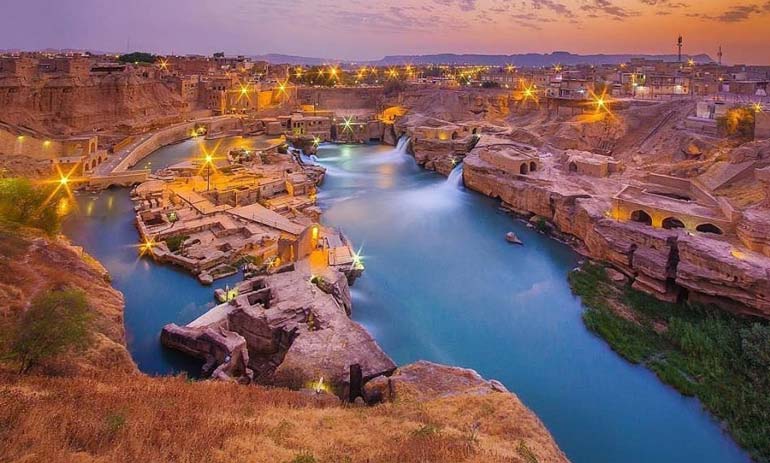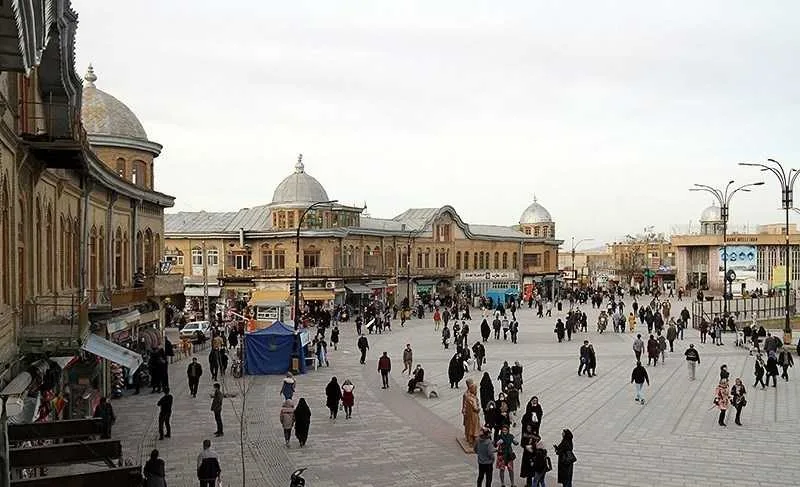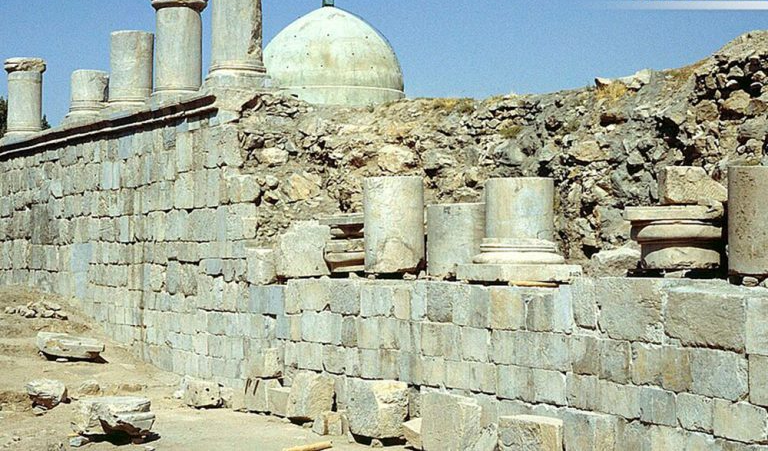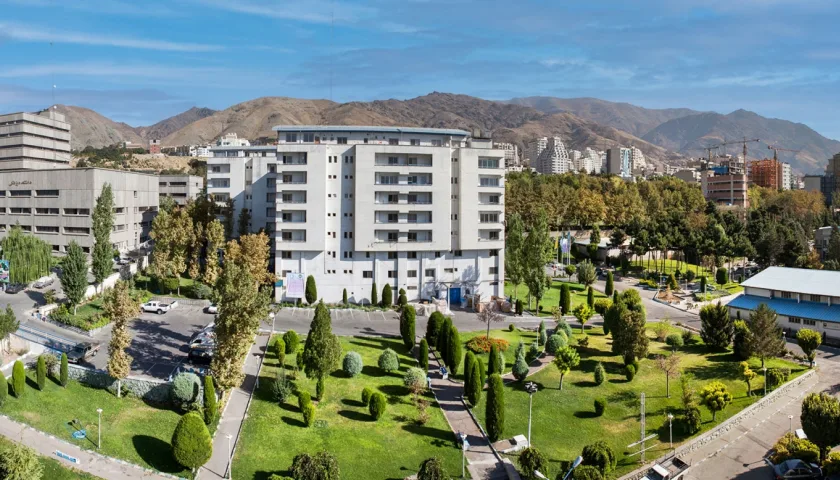Shushtar’s Liquid Legacy: Navigating Khuzestan’s Water Structures ?️
“It is impossible to read the history of Iran and not find any mention of the Khuzestan province. Khuzestan, indeed, is a province with global renown. The ingenuity and creativity of the ancient Iranian people have been exemplified in this region. I am certain that if you have ever sought a remarkable destination in this province, the name Shushtar has resonated with you. We believe it would be challenging to find a place in the world that reflects the brilliance and engineering marvel of ancient Iran as demonstrated by the hydraulic structures of Shushtar.”
“Imagine thousands of years ago, people lived creating artificial waterfalls, utilizing them for their mills. They supplied their city’s water system with these waters and their agricultural lands depended on it. The hydraulic structures of Shushtar are unparalleled and unique in their kind. I am certain that witnessing the grandeur and architectural magnificence of Shushtar’s water structures would captivate anyone.
If you are looking for the most fascinating attractions in Dezful or the sights of Khuzestan, pack your bags, as I’m sure after reading this article, you’ll be eager to book a ticket to Shushtar. Behold the genius of the world’s most remarkable hydraulic structures in the city of Shushtar.”
Exploring the Water Structures of Shushtar: It’s an Iranian Art, Pure and Simple!
When you lay eyes on the water structures of Shushtar for the first time, the sheer artistry of the Iranians is the first thing that comes to mind. Can you really witness the grandest irrigation project of centuries ago and not be awestruck?
The rich and tumultuous history of ancient Iran has always left wonders for its future generations, wonders that even echo beyond its borders. Shushtar, with its famous water structures, is one such legacy passed down from our ancestors.
The water structures of Shushtar stand as the largest industrial project that predates even the Industrial Revolution, a testament to the unwavering determination put into its creation. I’m not saying this; it’s the renowned French archaeologist Jules-Louis Diolé who mentions it in his travelogues.
Take a glimpse into the marvels of Shushtar’s hydraulic structures and witness the ingenuity that prevailed long before the industrial era.”
“People from all around Iran and the world visit Shushtar every year to witness the wonders of these global marvels, immersed in a watery world crafted by our forefathers using mud and bricks.
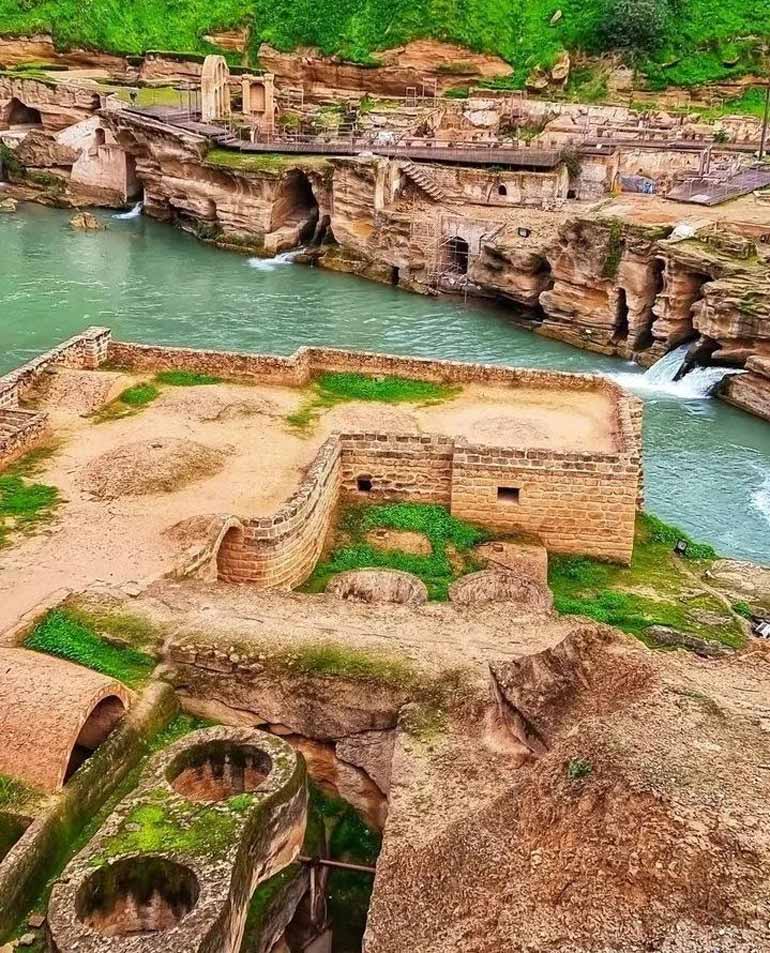
When you see the ensemble of Shushtar’s hydraulic structures for the first time, you understand why people from Iran and beyond make the journey to witness it themselves. For 2000 years, mud, bricks, and water have stood firm together, giving rise to 13 hydraulic structures that bring prosperity and life to the area.
Apart from the historical value that the Shushtar hydraulic structures hold, you cannot overlook its visual and emotional allure. The sound of waterfalls echoes in your ears, the wind creates small waves in the river amidst the structures, and you can see joyful birds flying around.
No matter how much I describe the marvels of Shushtar’s hydraulic structures, I’ve said too little. You must be there yourself to truly grasp every bit of its magnificence. Despite the challenges and changes these structures have endured, their existence is now in jeopardy, and one day, we might lose sight of this beauty and authenticity.
People from every corner of Iran or abroad bring themselves to Shushtar every year to witness the artistry of architects who have built something with nothing but earth and clay, something that remains difficult and even impossible to replicate today.
The entire hydraulic complex in the city of Shushtar consists of a total of 13 structures and was registered as a national heritage of Iran on December 1, 1998. In 2009, these structures were collectively inscribed on UNESCO’s World Heritage List.”
Where is Shushtar’s Hydraulic Structure?
The address of the Shushtar hydraulic structures is straightforward. To reach these structures in Shushtar, head to Shush, Do Khaharan Square, and Shariati Street.
Access Routes to Shushtar’s Hydraulic Structure
To reach the Shushtar hydraulic structures, you can use various means of transportation, including airplanes, trains, taxis, or private cars.
– By Airplane: Shushtar itself does not have an airport. However, you can fly to Dezful or Ahvaz Airport and then take a bus or taxi to Shushtar. The distance from Dezful to Shushtar is 60 kilometers, and from Ahvaz to Shushtar is 90 kilometers.
– By Train:Shushtar is connected to the national railway system. You can take a train to the city and then travel the 4.1 kilometers from the railway station to the hydraulic structures by car or taxi, which takes approximately 10 to 15 minutes.
– By Taxi or Private Car: If you are already in Shushtar, you can reach the hydraulic structures by walking, using a private car, or taking a taxi. The structures are located within the city, and the distance from 17 Shahrivar Square to the site is a 2-minute drive, covering a total of 500 meters.
Travel from Tehran to Shushtar
If you want to travel from Tehran to the Shushtar hydraulic structures, you can use various means, such as trains, airplanes, or private cars. The use of a private car may prolong your journey, as the distance from Tehran to Shushtar is 813 kilometers, taking approximately 9 hours by car.

History of Shushtar’s Hydraulic Structures
When discussing the Achaemenids, notions of prosperity, beauty, and flourishing come to mind. The first bricks of the Shushtar hydraulic structures were laid during this period. Some historians even claim that the order for constructing this complex was issued by Cyrus the Great.
While I cannot provide an exact date for its construction, historical writings from the Sassanid era mention that most of these structures, including bridges, dams, mills, waterfalls, canals, and tunnels, were built during that time.
The reconstruction and development of various parts of the Shushtar hydraulic structures began during the Sassanid era. This development started around 300 years after the birth of Christ. Shapur I placed great importance on this complex and made significant efforts to enhance it.
When the Roman Emperor Valerian was defeated by Shapur I in war, hundreds of Romans were taken captive by the Iranians. Shapur instructed them to contribute to the expansion and development of the Shushtar hydraulic structures.
Many renowned global tourists have visited these structures, expressing wonder and admiration. Numerous books, articles, and theses have been written about this hydraulic masterpiece, with one of the most famous being by the renowned Arab traveler Ibn Battuta.
The Shushtar hydraulic structures, constructed with bricks, clay, wood, and sarooj, have stood for hundreds of years. Various components were added over time. Initially just a dam, it later included features like mills and water channels for providing drinking water and irrigation.
Even now, Shushtar’s hydraulic structures remain as marvels from the Sassanid era, boasting beauty and wonders that still leave much to be said. Unfortunately, every arrival comes with a departure. From the Qajar period to the present day, nature has not been kind to these structures. Various parts have either been destroyed or are deteriorating.
Today, these structures serve only as scenic attractions, with no functional use since the Qajar era. Nevertheless, people from different parts of Iran continue to travel to Shushtar to witness the Iranian Venice and admire what our forefathers built.
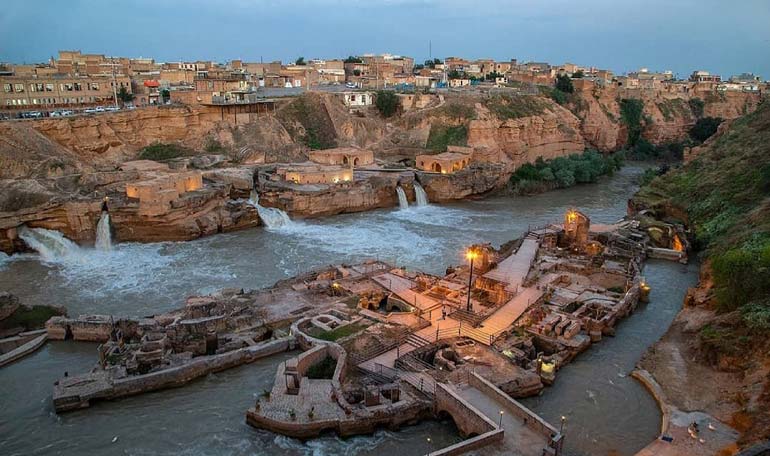
Reason for Naming Shushtar’s Hydraulic Structure
The historical water system of Shushtar is globally renowned as the Shushtar Hydraulic Structures. Until you see it up close, the reason for this nomenclature might not be apparent. The entire complex is comprised of interconnected systems working in harmony, all based on hydraulic principles.
Collaboratively, these structures have gained recognition throughout history as the Shushtar Hydraulic Structures. It is interesting to note that this site is so famous that many historical books consider it one of the wonders of ancient Iran and the world.
This honor is owed to the engineers who constructed dams on the Karun River, guiding its waters to various areas to bring prosperity and life to the Shushtar region.
Although the initial purpose of constructing the Shushtar hydraulic structures was to honor the water goddess and fertility, the city’s prosperity and civilization exceeded expectations. Instead of serving religious purposes, it transformed into a system for irrigating agricultural lands and powering mills for grinding wheat.
Therefore, over time, the Shushtar hydraulic structures continuously amalgamated with the famous hydraulic system. The name of the city it resides in, Shushtar, remained attached to it, and now people worldwide recognize it as the Shushtar Historical Hydraulic System.
Various Sections of Shushtar’s Hydraulic Structures
The Shushtar hydraulic structures, known as one of the most captivating tourist attractions in Khuzestan, consist of 13 main sections, connected by features like bridges and tunnels. Below are the various sections to familiarize you with them:
Waterfalls and Water Mills:
When entering Shariati Street, you will encounter several waterfalls and water mills. This is the southern section of the Band-e Kargar Bridge, including a series of dams, water channels, water mills, and tunnels. During the operation of the Shushtar hydraulic structures, when the water level in Gargar rose, it entered the channels and poured onto the mills, creating beautiful waterfalls.
Nowadays, the multiple mills are no longer operational, and only Reza Golab Mill is still in use. You can still witness the grace and beauty of the handmade structures by Iranian engineers.
Read more about the tourist attractions in Andimeshk; a city with amazing rivers and dams.
These are just a few of the many sections that make up the Shushtar hydraulic structures. The intricacy and engineering marvel of this historical site continue to captivate visitors from around the world.
Castle of Salasel
The oldest section of the Shushtar Hydraulic Structures is the Castle of Salasel. When you look at it, its military function becomes evident. Originally, this castle served a military purpose and was designed to protect the city.
Another function of this castle was to control the water of the Daryun River. The castle itself had various sections such as Shabestan (night prayer hall), tower, carpentry workshop, barracks, fence, granary, and a moat. Unfortunately, much of the castle has not survived, and only the tunnels of the Daryun River and a few underground rooms remain.
Kolah Farangi Tower
Before the Band-e Mizan, a tower named Kolah Farangi (Foreigner’s Hat) was part of the Shushtar Hydraulic Structures. This tower, placed on foundations four meters tall, is designed with eight sides and adorned with carved stones. However, only seven meters of its height remain.
The exact reason for the construction of this tower is still unknown, but some believe it was where Shapur Sassanian supervised Roman soldiers and laborers. You can easily see Kolah Farangi Tower from the 17th of Shahrivar Square.
Band-e Mizan (Mizan Dam)
Band (dam) is one of the most crucial parts of the Shushtar Hydraulic Structures. This section has multiple openings and divides the river water into two parts, Shoteit and Gargar. Its functioning is such that if the flow of water in Shoteit exceeds one-third, the surplus water is directed to Gargar. It operates in the opposite way as well. This unique architectural design earns it the name “Band-e Mizan,” meaning the dam that divides the water equally. It is also known by other names such as Qeisar, Shapouri, Doltashah, Taraz, Khaghan, and Mohammad Ali Shah. The dam is constructed from stone and saroj and is located at the end of the Kolah Farangi Tower.
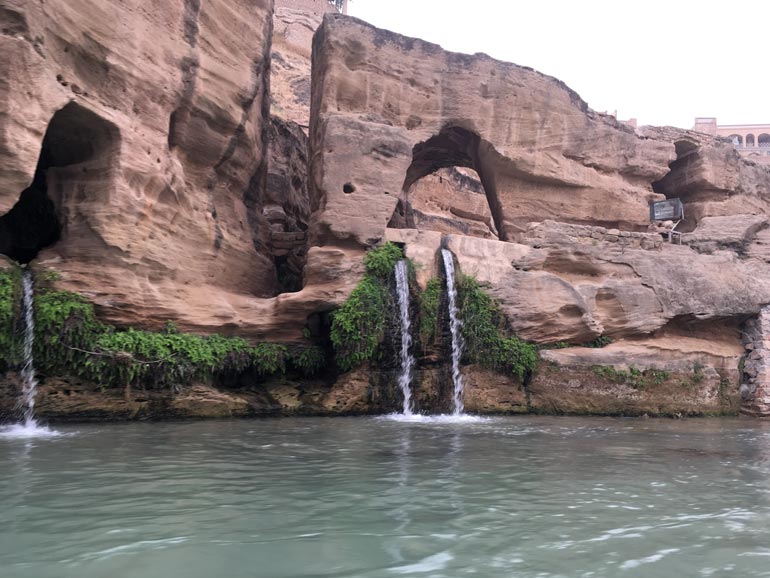
River and Band-e Gargar Bridge
The Karun River has several branches, and the Gargar River is one of them. This river was artificially created by the order of Ardeshir Sassanian. The riverbed is paved with stones and connected with metal brackets to prevent it from deepening. This river aids in the cycle of the Shushtar Hydraulic Structures.
In the lower part of the Band-e Mizan, there is a mill, and the Band-e Gargar Bridge, along with three other tunnels named Biliti, Shahr, and Seh Kooheh, supply water to it. The water used to pass over rocks and through tunnels to move the mill. Now that there’s no one to grind the wheat, the water cascades over the rocks, creating a delightful view.
Band-e Borj-e Ayar Bridge
On the Gargar River, at the bottom of the waterfalls of the Shushtar Hydraulic Structures, the Band-e Borj-e Ayar Bridge is located. The water for this bridge was supplied through the Biliti tunnel. You can still see the remaining rooms and channels in the eastern part of the Borj-e Ayar Bridge.
Band-e Shadrovan Bridge
If you walk along the Karun River, you can still see the remains of one of the most important bridges of the Shushtar Hydraulic Structures. The Band-e Shadrovan Bridge, built with bricks by Shapur I, was designed to raise the water of Shushtar. Ibn Hawqal, who has spoken about the Band-e Shadrovan Bridge and seen it up close, mentioned it in his book “Surat al-Arz.”
Shah Ali Bridge
Shah Ali Bridge is, in fact, the same as Band-e Shah Ali, with three significant openings. This bridge is located over the Daryun River. Shah Ali Bridge was a connecting bridge and was used during the Sufi and Pahlavi periods to connect Shushtar to its southern villages. However, a new bridge was built between Ahvaz and Shushtar, rendering the use of this bridge obsolete.
Band-e Lashkar Bridge
Next to Imamzadeh Abdullah and over the Raghz River, the Band-e Lashkar Bridge is part of the Shushtar Hydraulic Structures. Shushtar had six historical gates, and one of them was next to this bridge. You can still see the remnants of it. This place is still standing, and it was restored in 2008.
During the restoration of the Band-e Lashkar Bridge, the remains of one or two Parthian graves were also found next to its foundations. This suggests that these individuals may have worked here and were buried on the spot.
Band-e Khak (Khak Dam)
From the Daryun River, water named Raghz separated from it in the Shushtar Hydraulic Structures. This water was exchanged between these two rivers by the Khak Dam. This structure is designed in a U shape and has two different parts, one open and one covered.
This dam was designed to prevent flooding. Thanks to this dam, the flood did not threaten the plains of Mianab and Shushtar. Unfortunately, in the 1960s, a large part of this dam was demolished to build a belt highway, leading to its destruction.

Band-e Dokhtar-e Daryun
The Karun River passes near the Dokhtar Castle from the last mountain gorge. They have named the dam in this section Band-e Dokhtar-e Daryun, taking its name from the Dokhtar Castle. However, some archaeologists believe that this dam is dedicated to the goddess of water and fertility, Anahita, which is why they call it Band-e Dokhtar.
Sika
As mentioned, the Shushtar Hydraulic Structures were essentially a complex of dams and mills, known as Sika. Sika consisted of 32 mills that converted water power into motion to operate all these mills. The Sika area was used for recreation and relaxation and was designed as a covered space.
A blue river flows in the wall of Sika, architecturally fascinating. The water of this river pours into an eight-sided basin, creating an interesting space.
Ancient and Famous Staircase of Shushtar Hydraulic Structures
If you visit the Shushtar Hydraulic Structures, be sure to check out the southern part, where, apart from the beautiful waterfalls descending on the rocks for centuries, there are 200 steps. What is interesting about these steps is the ancient history of this section and especially its structures. The staircase connects the waterfalls to the residential area, and there are small rooms along this path. Hordot has climbed these stairs and talked about them 2500 years ago.
At that time, he believed that these steps were 1000 years old. The small rooms and famous structures were thoroughly examined, estimated to be built for guarding purposes, and about 4000 years old.
Best Time to Visit Shushtar Hydraulic Structures
Usually, spring is the best time to travel to Khuzestan and the city of Shushtar to see the Shushtar Hydraulic Structures. The Shushtar Hydraulic Structures are worth visiting in spring. In the months of Ordibehesht and Khordad, many travelers from around come to see this masterpiece and architectural wonders. To go to these structures, you need to buy a ticket, available at the entrance booth.
Visiting the Shushtar Hydraulic Structures is free from 8 AM to 8 PM, and you can visit it at various hours. In general, one to two hours will be sufficient to see all its sections. It tends to be busier in the afternoons, and if you want to avoid the crowds, you can go there at 8:30 or 9 in the morning.
Facilities of Shushtar Hydraulic Structures
The Shushtar Hydraulic Structures are ancient and historical, so they are heavily protected, and as a result, they may not have many amenities. However, there are shops and hotels near the structures that provide good services to travelers.
All hotels have a mosque and clean and tidy rooms for accommodation near the Shushtar Hydraulic Structures. You can also find some good supermarkets nearby. But remember, you cannot bring your food inside the structures.

